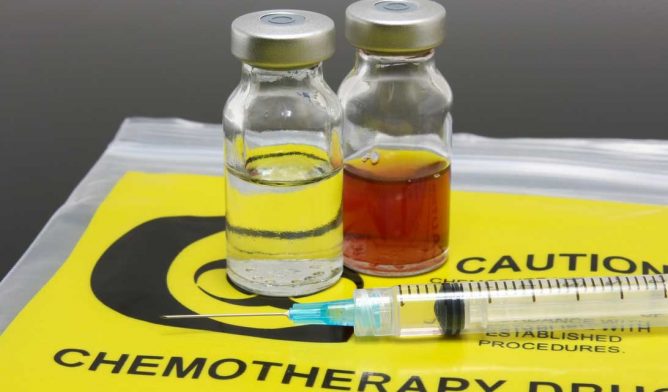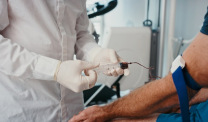Mesothelioma Chemoperfusion Trial Shows Impressive Results
Research & Clinical TrialsWritten by Tim Povtak | Edited by Walter Pacheco

Study statistics show the benefits of the novel transarterial chemoperfusion treatment being used successfully at the Moffitt Cancer Center in Tampa for patients with relapsed pleural mesothelioma.
Russell Lamkins — working on the roof of a neighbor’s house — shows them even better.
He is living proof. This latest mesothelioma treatment has potential.
Lamkins, 73, was first diagnosed with mesothelioma in 2014. He was the second patient to enroll in the mesothelioma clinical trial in March 2016, soon after standard-of-care chemotherapy and immunotherapy had failed him.
“At that point, I had no choice,” he said.
Principal investigator Dr. Bela Kis presented impressive results from his groundbreaking clinical trial at the virtual Society of Interventional Radiology 2020 Scientific Meeting June 14, about the same time Lamkins was cutting his grass and trimming the hedges.
“It [the treatment] seems to be working for me,” Lamkins said from his home in southwest Florida. “If not, I would have been gone a long time ago. I’d be dead by now.”
Kis’ presentation at the conference was awarded Society of Interventional Radiology Abstract of the Year.
Chemoperfusion Procedure Is Minimally Invasive
Lamkins has emerged today as an inspiration, a beacon of hope for many with this aggressive, incurable disease, and a shining example of how important a mesothelioma clinical trial can be.
“We can’t do magic, but we’ve shown we can extend survival and improve patients’ lives with this treatment,” Kis told The Mesothelioma Center and Asbestos.com. “I believe in the future of this treatment.”
Transarterial chemoperfusion therapy starts with identifying specific blood vessels feeding the mesothelioma tumors, then overloading them with a higher-than-normal dose of chemotherapy.
This high concentration of drugs directed at the diseased tissue leads to a maximized effect with only limited side effects compared to typical systemic chemotherapy, which circulates throughout the body.
In this procedure, Kis injects one-third of the chemotherapy cocktail directly into the internal mammary artery that supplies the pleura lining. The other two-thirds go into the descending aorta, which reaches the intercostal vessels supplying the pleura.
“It’s technically challenging, but it’s my expertise,” said Kis, an interventional radiologist. “It’s a relatively easy procedure.”
The chemotherapy mixture includes cisplatin, gemcitabine and methotrexate. Patients are treated every four weeks. The procedure is minimally invasive and lasts one hour, with a second hour of recovery.
Mesothelioma Treatment Has Minimal Side Effects
Lamkins and his wife Sandi usually have an early morning treatment appointment and leave the cancer center by lunchtime. Although Lamkins drives their motorhome the 130 miles to Tampa each month, his wife always drives home.
For the next few days, Lamkins feels sluggish and lacks his usual energy. By the end of the week, though, he is back doing chores with an eight-hour workday.
“My wife always has a long list of things for me to do,” he said with a chuckle. “I tell people, ‘I can’t die now. I still have a long list of chores to get done.’ A positive outlook really helps.”
Although the majority of patients in the clinical trial have not been as fortunate as Lamkins, the survival advantages have been impressive, considering patients enrolled only after the first- and second-line treatments already had failed them.
Most arrived as a last resort with unresectable disease.
Chemoperfusion Clinical Trial Shows Impressive Results
The study presented this month involved 27 patients with a disease control rate of 70.3%. Median progression-free survival, from enrollment into the trial, was 4.6 months.
Median overall survival was 8.5 months from time of first treatment. There was no treatment-related mortality and a major complication side effect of only 1.4%. Eighteen of the 27 patients have died since 2016.
The median number of treatments per patient was four. Lamkins, by contrast, has had more than 30.
He had stopped treatments twice, once to accommodate motorhome travel plans across the country with Sandi, and once to try a new immunotherapy treatment that didn’t work for him. He returned to the trial last March.
Lamkins also credits Sandi, and her strict all-organic diet, for his success.
Moffitt Clinical Trial Still Enrolling Patients
Moffitt Cancer Center is the only treatment center in the U.S. doing the clinical trial with transarterial chemoperfusion for mesothelioma patients. Other centers have found the procedure effective with a certain type of liver cancer.
The procedure is being used with mesothelioma in Germany and Egypt, and finding even better results. Kis still needs to enroll a few more patients to complete his phase II study.
He also thinks the procedure will be proven more effective in a multicenter, phase III study where he could raise the dosage levels, something he can’t do in the current protocol.
“One of the most important takeaways for the patient is that there are only minimal side effects,” he said. “To see these promising results with so few side effects is encouraging. We’re able to make a positive impact on quality of life for patients.”







